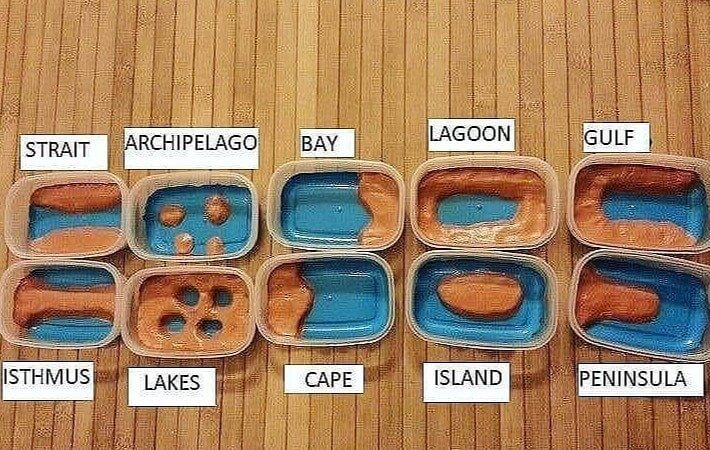Remember those geography classes from school with all the complex terms for various land formations? It’s time to revisit those concepts, but in a way that’s far easier to grasp. This article is your guide to understanding the diverse landforms that decorate our planet, from the common to the not-so-familiar.

The Basics: From Islands to Isthmuses
Let’s start with the basics. Islands are land masses surrounded by water, while isthmuses are narrow strips of land with sea on either side, connecting two larger land areas. These are terms most of us are familiar with. But what about the more obscure landforms?
Rediscovering Lagoons, Capes, and Isthmuses
Lagoons, capes, and isthmuses might sound like foreign concepts, but they’re simply specific types of land and water formations. A lagoon is a shallow body of water separated from a larger sea by a small landmass or a coral reef. Capes are pointed pieces of land that jut into the sea, and isthmuses, as mentioned, are land bridges between larger landmasses.
The Misunderstood Lagoon
A common misconception about lagoons is their size and relation to other bodies of water. They are often thought of as small, isolated pools when, in fact, they’re typically connected to larger seas or oceans. The separation is usually a narrow strip of land or reef that can experience overflow, linking the lagoon to the greater body of water.
Visual Learning: Land Formations in Perspective
A visual comparison can bring these terms to life. Imagine a Tupperware container as a simple model. An island could be represented by a single object in the middle, completely surrounded by water. An isthmus would be a thin piece of tape connecting two larger objects, with water on both sides. For a lagoon, place a smaller container within the larger one, partially filled with water, and separated by a thin barrier—that’s your lagoon, adjacent to a larger sea.
Understanding land formations doesn’t have to be a memory test from your school days. By breaking down these terms and visualizing them in everyday contexts, we can better appreciate the incredible variety of landforms that exist on our planet. Whether it’s the serene beauty of a lagoon or the rugged prominence of a cape, each formation has its unique characteristics and story to tell.
The Intriguing Cape
Capes are fascinating land formations that have guided sailors for centuries. They are easily spotted extending into the ocean, often marking hazardous spots or significant turning points in shipping routes. Unlike their more dramatic counterparts, the peninsulas, capes are usually smaller and less pronounced but still play a vital role in coastal geography.
The Dynamic Isthmus
The isthmus, a narrow strip of land flanked by water on two sides, is a dynamic land formation that has historically been crucial for trade and travel. The famous Isthmus of Panama, for example, is so significant that it spurred the creation of the Panama Canal, altering global shipping routes forever. Isthmuses are not just land bridges; they are catalysts for human connection and progress.
The Diverse Peninsula
Peninsulas are extensions of land surrounded by water on three sides, offering some of the most picturesque landscapes in the world. From the rugged coasts of the Italian Peninsula to the sandy shores of Florida, peninsulas offer diverse ecosystems and have been hubs of human settlement due to their strategic locations and abundant resources.
The Majestic Mountain Range
Moving away from the water, mountain ranges are towering land formations that stretch across continents, forming the backbone of the landscapes they dominate. They are created by tectonic forces and erosion over millions of years and are home to some of the most diverse flora and fauna on Earth.
The Expansive Plains
In contrast to the vertical drama of mountains, plains are vast stretches of flat or gently rolling land. They are often referred to as the breadbaskets of the world, with their fertile soils providing the perfect conditions for agriculture and supporting large populations.
The Mysterious Valley
Valleys, often carved by rivers or glaciers, are elongated depressions surrounded by higher land. They are natural conduits for water and pathways for wildlife and humans alike. Valleys can be lush and fertile, supporting rich ecosystems and agriculture, or they can be arid and desolate, offering stark beauty and solitude.
The Enigmatic Plateau
Plateaus are areas of highland, usually consisting of relatively flat terrain. They are often found near mountains and can be formed by volcanic activity or the gradual uplift of the earth’s crust. Plateaus are known for their rich deposits of minerals and fossils, making them significant for both natural history and human industry.
Embracing the Landscape
Understanding the variety of land formations enriches our appreciation of the planet’s beauty and diversity. These natural structures have shaped human history, influencing where we settle, the routes we travel, and the stories we tell. They are not just features on a map; they are the contours that define our world’s face.
By exploring these landforms, we connect more deeply with the environment and gain insight into the forces that have shaped our earth. Whether it’s the serene lagoon or the majestic mountain range, each formation holds a key to understanding the natural world and our place within it.
As an Amazon Associate we earn from qualifying purchases through some links in our articles.
